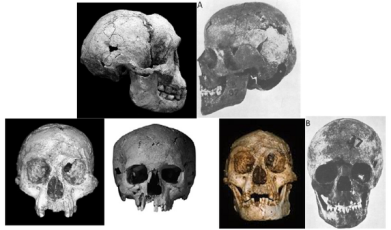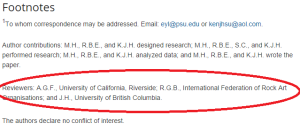Last month I wrote about a new round of controversy surrounding the hobbit. Not the series of films (although I think the decision to split it into 3 films remains controversial and, in my opinion, a mistake) but the diminutive species (Homo floresiensis) of human that lived around 12,000 years ago. The controversial claim was that it wasn’t a separate species of human, but simply a regular Homo sapiens. I disagreed.
Since then several other palaeanthropologists have also voiced their criticisms of the Down syndrome hypothesis; and boy have things got nasty. Not only has the science been disputed but there have also been suggestions of misconduct, with one critic claiming that the authors used their position to effectively force the article through peer review (a pre-publication process where other scientists vet research to ensure it is up to snuff). As the Guardian reports,
…the authors of the Down’s syndrome paper [managed] to avoid independent peer review because one is an academy member and so is allowed to select his own referees when submitting the paper.
“The article is a contributed submission from an academy member, Kenneth Hsu, … who selected referees that were also without expertise in fossil hominin skeletons … This is an outrageous abuse of the peer review process.” [ - Professor Peter Brown, one of the discoverers of the hobbit]
But these authors haven’t taken these attacks lying down, taking to blog comments to defend themselves:
It would have been a courtesy for Dr. Stringer to have read our papers before commenting on them, but perhaps he did read but merely not understand them.
That’s a severe science burn right there. As I said, nasty stuff. But is there anything to these claims, or is are they the just the result of people getting defensive over their pet idea/species? First, lets deal with the above-the-belt stuff, the criticisims raised about the science behind the Down syndrome hypothesis. Does it hold any water? Not as much as you may think (considering the Down syndrome hypothesis is pretty wrong)!
You see, these researchers weren’t just claiming it was someone with Down syndrome but someone from a population of small people; such as the Rampasasa, a group of “pygmies” living near the site the hobbit was found. This is relevant because a lot of the criticisms of the science behind the Down syndrome hypothesis is based around the fact that it’s too small. One palaeoanthropologist quoted in the aforementioned Guardian article notes that “no one with that condition has a tiny cranium only 400cc in capacity as floresiensis does“. However, Kenneth Hsu and the other Down proponents would probably simply retort that this explained away by the fact the people they’re looking at had a small stature to begin with.
So are the critics of the Down syndrome hypothesis completely unjustified (except, of course, my obviously perfect critique of the way they cherry pick data)? Well, some contend there are key differences between people with Down syndrome and the hobbit that can’t be explained by size. Professor Falk posted the image below to twitter (via Chris Stringer); showing that even when you take into account size differences there are still fundamental differences between the skull of someone with Down syndrome and the hobbit (known as allometric diifferences).

In each of the comparisons the hobbit on the left, Down syndrome on the right.
Of course, this being twitter there’s no statistical comparison definitively showing they’re different, although I still find this very compelling. We may have to hold off putting the final nail in the Down hypothesis coffin until this sort of data is presented in a journal (which Chris Stringer seems to hint is coming soon). So it looks like palaeoanthropologists have their hammer in the air, ready to swing it down on said nail, so we can soon put this nastiness behind us.
But what of the more gossipy claims? Did the authors really “abuse” the peer review system to shield their paper from critics?
At this point it’s probably worth noting that they published two papers on the subject. One advocating the Down syndrome hypothesis; the other just suggesting that the hobbit had some sort of pathology (ultimately trying to argue that such specimens shouldn’t be used to define a new species).
Now, as far as I can tell they only used Kenenth Hsu’s magical peer-selecting ability on one of these two papers: the one advocating specifically for Down syndrome. In other words, they got one paper claiming the hobbit was a human with a disease through legitimate peer review! So if they managed to get a paper published “legitimately” perhaps there isn’t any real problem here. There are still a few unanswered questions. For example, whilst the peers selected were far from incompetent (in fact I’ve discussed some of their work on this blog before) they weren’t exactly experts in hominin fossils. But the fact is that this is hardly an open and shut case of misconduct.

The footnotes of the Down syndrome article, noting the reviewers. This section was missing from their other article.
These blogs, discussions and newspaper articles form a new round of peer-review, allowing us to vet research more thoroughly than we would’ve thought possible just a decade ago. And whilst I don’t expect these conversations be dry and technical, we have to remember they are ultimately about science. So they should follow the scientific process of looking for evidence. If that evidence leads to calling someone an idiot I’m fine with it (I do it a fair bit myself after all). But the fact is that the evidence about these researchers “abusing” the peer review system is far from conclusive; yet it seems to have dominated the discussion of the subject.
And I think that’s the most disturbing part of all this. Not that some of the critiques of the Down syndrome hypothesis are invalid, not that some of the research avoided regular peer review. No, it’s that so many good writers, readers and scientists have been distracted by the whiff of a controversy. Please, stay focused, stay with the evidence and, most importantly, stay classy.


